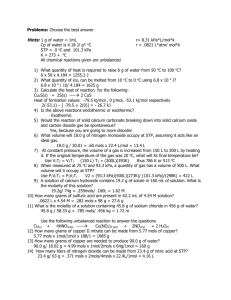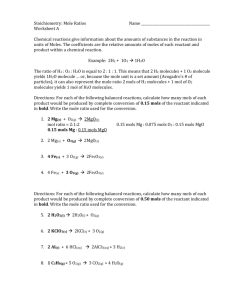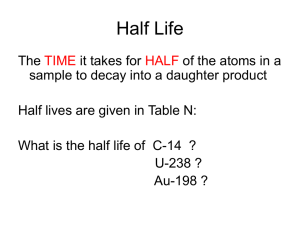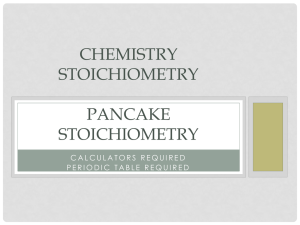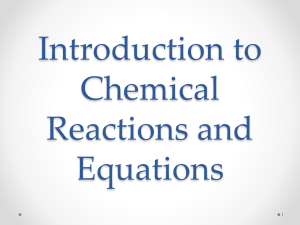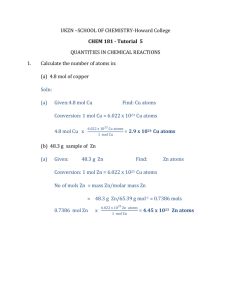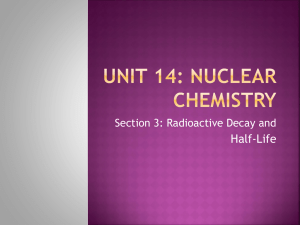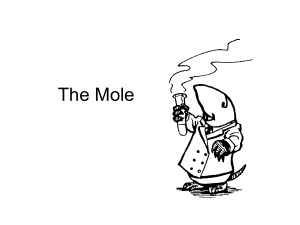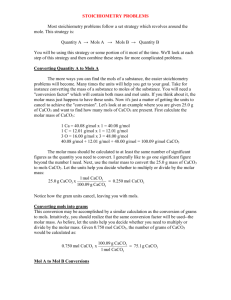Chapter 12 Chemical Quantities
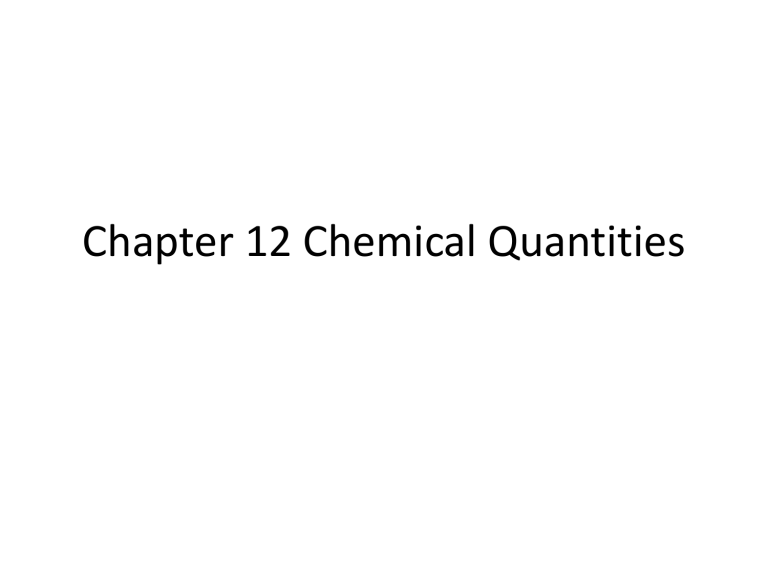
Chapter 12 Chemical Quantities
Objectives
• 12.1 Compare and contrast the mole as a number and the mole as a mass
• 12.1 Relate counting particles weighing samples of substances
• 12.1 Solve stoichiometry problems using mass
Objectives
• 12.2 Predict quantities of reactants and products in chemical reactions.
• 12.2 Determine mole ratios from formulas for compounds
• 12.2 Identify formulas of compounds using mass ratios
• 12.2 Calculate percent yield
Stoichiometry
• A method of determining how much can be made
– In the business world, the question would be something like this: How many hamburgers can I make if I have 58 hamburger patties, 63 Buns, 120 pickle slices, and 32 ounces of Ketchup
– It takes 1 hamburger patty, 2 buns, 4 pickle slices, and 1 ounce of ketchup to make a burger
In the Chemistry World
• 4NH
3
+ 5O
2
6H
2
O + 4NO
• How many grams of water can be made from 17grams of Ammonia and 32grams of
Water?
– Looks much more confusing than our real life example, but is the same
2 Buns + 1 Patty + 1 Cheese + 3 Pickles
1 Hamburger
– 2 Buns
– 1 Beef Patty
– 1 Slice of Cheese
– 3 Pickle Slices
• 50 Buns, 30 Beef Patties, 22 Slices of Cheese,
64 Pickles
• 45 Buns, 16 Beef Patties, 31 Slices of Cheese,
48 Pickles
Warm up
• To make an extremely tasty Vanilla Sundae, it takes the following materials
– 1 Plastic Cup
– 3 Scoops of Ice Cream
– 2 oz of Caramel
– 2 oz of Hot Fudge
• How many tasty Vanilla sundaes can be made from the following
1 Cup + 3 Scoops + 2 oz Caramel + 2 oz
Hot Fudge 1 Sundae
– 1 Plastic Cup
– 3 Scoops of Ice Cream
– 2 oz of Caramel
– 2 oz of Hot Fudge
• 15 Cups, 42 Scoops of Ice Cream, 24 oz of
Caramel, 32 oz of Hot Fudge
• 19 Cups, 62 Scoops of Ice Cream, 46 oz of
Caramel, 53 oz of Hot Fudge
Chemical Conversions
– Can’t count individual atoms
• Count by mass
– Done by most manufacturing places who don’t want to count individual pieces
– A penny weighs 2 grams, if you have 1200 grams of pennies, how many pennies do you have?
• Different elements/isotopes have different masses
– Mass determined by amount of protons/neutrons
Periodic Table Connection
• The periodic table gives you the average mass of atoms which make up that element.
• The atomic mass on the periodic table directly converts into the mass that we can measure
– If you have 10 grams of hydrogen and 10 grams of oxygen, you have more hydrogen atoms than oxygen atoms
Mol: Avogadro’s Constant
• The mass on the periodic table is equivalent to a Mol of the atom
– A dozen = 12
• A mol is a counting unit: 6 x 10 23
– 12 grams of carbon has 6 x 10 23 atoms of carbon
• Is a unit, or haven’t you heard, containing 6 x
10 to the 23 rd . That’s a 6, with 23 zero’s at the end, much to big a number to comprehend
Stoichiometry
• Is the application of your knowledge from previous slides to actual chemistry
• Example: How many mols of Ammonia can be made from 5 mols of N
2 and 12 mols of H
2
?
• N
2
+ 3 H
2
2 NH
3
• 5 mols of N
2
10 mols NH
3
• 12 mols of H
2
8 mols of NH
3
Stoichiometry Term
• Limiting Reagent: The substance you run out of first
– Hydrogen in previous example
• Excess Reagent: The substance you have more than enough of
– Nitrogen in previous example
Practice
• C
3
H
8
+ 5 O
2
3 CO
2
+ 4 H
2
O
• A) How many mols of CO
2 from 3 mols of propane and 7 mols of Oxygen?
• B) How many mols of Propane and Oxygen are required to produce 9 mols of Water?
Practice
• 2 C
4
H
10
+ 13 O
2
---> 8 CO
2
+ 10 H
2
O, show what the following molar ratios should be.
– a. C
4 b. O
2
H
10
/ O
2
/ CO
2
O c. O
2 d. C
4 e. C
4
/ H
2
H
10
H
10
/ CO
/ H
2
2
O
Molar Mass
• The mass of 1 mol of something is called the molar mass
– 1 mol of carbon is 12 grams (right off the table)
– 1 mol of water is 18 grams (2 mols of water and 1 mol of oxygen)
• What is the molar mass of Methane? Calcium
Chloride?
Conversions
grams molarmass
Mols
grams
Mols
(
molarmass
)
How many atoms/molecules?
• In 6 grams of Carbon?
• In 36 grams of water?
• In 88 grams of Carbon Dioxide?
– 1 Mol = 6 x 10 23
Mols and Gases
• 1 mol of any gas takes up 22.4 L of space at
STP
• What is the density of Nitrogen gas at STP?
– Revisit Gas laws… PV =nRT
– We’ll pass on this for now, but if you really like chemistry, you’ll do stoichiometry with gases quite a bit in college.
– For example… following slide
Examples of Real Life Stoichiometry and Gases
• Air bags
– How much sodium azide needs to be placed into the bag?
• Car engines
– How much fuel should be placed into the piston?
(size of piston makes a difference)
Practice with Grams conversions
N
2
(g) + 3H
2
(g) 2NH
3
(g)
• How many mols of hydrogen gas are required to make 68g of ammonia? Assume you have lots of nitrogen
• Will have another powerpoint dedicated to solving step by step these type of problems
Theoretical and Actual Yield
• In a chemical reaction, you don’t always get the amount of what you expected
– Sometimes you make some products which you didn’t desire but end up with. For example, a pure combustion engine would produce only carbon dioxide and water. However, in real life, some carbon monoxide is made, as well as nitrogen oxides as well
Theoretical yield and Actual Yield
• % Yield = Actual Yield / Theoretical Yield
– It is like your grade. 100% is possible, how much do YOU actually attain is your percent yield
• A certain reaction is supposed to produce 15 grams of ammonia but only 12 grams of ammonia are obtained. What is the % yield of the chemical reaction?
Mass Percents
• How much of a substance by mass is a certain element?
• Water has a mass of 18grams. 2grams are hydrogen and 16g are oxygen. The mass % of water by element is
– Oxygen = 16g O / 18 g total = 89%
– Hydrogen = 2 g H / 18 g total = 11%
• Sugar is what % carbon?
Mass Percents/Chemical Formulas
• A certain chemical has a molar mass of 282 g.
It is composed of 76.5% C, 12.1 % H, and 11.3
% O. What is the chemical formula of Oleic
Acid?
• 282 g x 0.765 = 215.73 grams Carbon
• 215.73 g Carbon / 12 g = 18 mols Carbon
Mass Percents and Chemical Formulas
• 282 g x 0.121 = 34 .1 grams of Hydrogen
• 34.1g H / 1 g = 34 mols H
• 282 g x 0.113 = 31.8 grams of Oxygen
• 31.8 g / 16 g = 2 mols O
• Formula C
18
H
34
O
2
Chemical Formulas
• Can be determined by knowing the ratio between the atoms and the molar mass of the atoms
• Done using mass percentages as well
• Empirical Formula = Lowest whole number ratio between atoms
– Ethane Molecular = C
2
H
6
– Empirical Ethane = CH
3
What is the Formula?
• Empirical of the below
– C
6
H
12
O
6
– C
2
O
4
• Molecular Formula
– Empirical NH
2
Molar mass 32g
– Empirical CO Molar mass 56g
